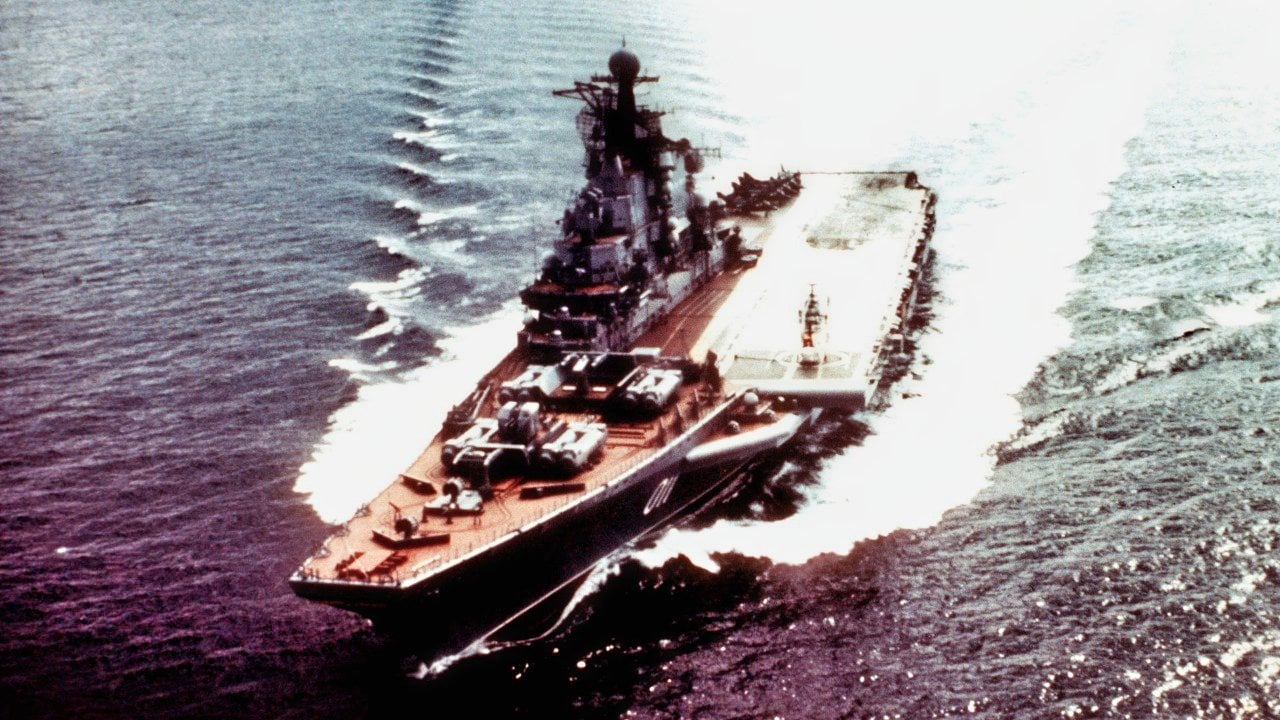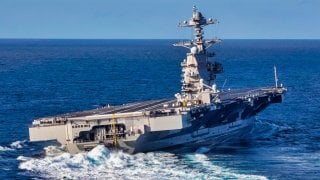Russia's Desperate Aircraft Carrier Plan Looks Like an 'Unmitigated Disaster'
Russia’s ambition to build a fleet of aircraft carriers is highly unrealistic and strategically misguided given its historical and geographical constraints.
Summary and Key Points: Russia’s ambition to build a fleet of aircraft carriers is highly unrealistic and strategically misguided given its historical and geographical constraints.

-The country's limited access to warm water ports and the massive costs associated with building, staffing, and maintaining aircraft carriers make this plan impractical, especially during the ongoing war in Ukraine.
-Instead, Russia's naval strength lies in its submarine fleet, which has historically posed the greatest threat to Western navies. Investing in aircraft carriers would likely be a waste of resources in the current geopolitical climate.
-Clearly, if Russia builds another aircraft carrier, history shows it will be an unmitigated disaster.
Russia’s Delusional Plan to Build a Fleet of Aircraft Carriers
The Russian Federation is a land power. Historically, Russia has been a continental power with limited access to the sea. Today, there are four warm water ports that the Russians control. Only one of them, Vladivostok along the Pacific Ocean, is within Russia’s contiguous borders.
The other three are located in Russian-controlled territory but they are unconnected from the Russian heartland.
There is one along the Baltic Sea in Kaliningrad (the small patch of land separating Poland from Germany that the Red Army took and held after the Second World War). There is the infamous Black Sea port at Sevastopol in Crimea. And the Russians have a port in Tartus, Syria, along the Eastern Mediterranean Sea.
The Soviet Naval Threat Wasn’t Above the Sea
Despite their limited access to warm water ports, every Russian ruler since Peter the Great has striven to make their country more of a maritime force. Even at the height of Russia’s power—during the Soviet era in the twentieth century—the Russians were never able to go toe-to-toe with the Americans at sea.
For most of the Cold War, the Soviet Navy lacked a capital ship comparable to the American aircraft carrier. What’s more, the Soviet fleet never reached the level of complexity that the U.S. Navy’s fleet achieved.

Of course, the Soviets could still threaten the Americans at sea.
Indeed, the Soviet submarine threat to Western navies was real. And the Reds had a handful of capital ships of their own that could complicate the naval ambitions of the Americans and their allies. But there was never anything reliable at sea on the order of what the Americans possessed. Even when the Soviets finally decided to commit themselves to matching America’s aircraft carrier capabilities, as they did in the 1980s with Admiral Kuznetsov, it was a grievous disaster.
Decades have passed since that warship was built and deployed.
The Russians still attempt to utilize Admiral Kuznetsov as a critical element in their navy. But it’s been holed up in port for years—and it might never put to sea again, due to a combination of age and mismanagement. Using that experience as impetus for creating an entire carrier fleet sends good money after a bad investment.
The Russians are not a naval superpower the way the Americans are and the British before them were. Geography conspires against such ambitions.
That’s not to say that Russia is not a naval power at all. It is. But that is to say that Russia’s naval capabilities—its strengths—lie beneath the Deep Blue. Russia’s submarine fleet, notably their nuclear-powered submarines, have always been the element of their navy that threatens the Americans the most.
Yet, Russian planners since at least 2017 have announced lofty plans for building an indigenous aircraft carrier fleet.
Mass Russian Delusions About Domestically Built Carriers
Most recently, Russian planners have spoken about their vision of having a minimum of four aircraft carriers operating in their navy (two in the Baltic Sea fleet stationed at Sevastopol and two based in Vladivostok as part of the Pacific Fleet).
On paper, this sounds great for a Russia that aspires to reclaim its great power status. But aircraft carriers are insanely expensive and onerous to build, staff, and maintain.
Moscow says its carriers would be smaller than the American fleet of supercarriers. Regardless, this is a massive investment of time, resources, and money—at a time when the Russian economy is on a total war footing against Ukraine.
And in Ukraine, the war will be decided on the ground, not the seas.
The Russian plan for a minimum of four aircraft carriers is aspirational. It’s also totally unrealistic. The Russians have managed to avoid the biggest bite from the Western imposed sanctions.
Russia’s defense industrial base, rather than withering under the strain of Western economic warfare, has thrived. And while certain creature comforts have been lost in the wake of Moscow’s invasion of Ukraine, the Russian economy is doing better than almost anyone (except this author) would have anticipated in the aftermath of the sanctions imposed upon Russia.
Learning the Wrong Lessons from Ukraine?
But, as we’ve seen with the Russian T-14 Armata Main Battle Tank, or their fifth-generation warplane, the Su-57, Moscow is skittish about risking their more advanced platforms in the fiery Ukraine conflict. While Russia’s wartime defense industrial base is humming, their base is building older, simpler systems.
Trying to readily replace the newer, more complex systems will strain their industrial base at a time when Russia just needs quantity over quality.
Over time, should the Russians win their war in Ukraine, to keep their defense industrial base propped up rather than have it contract with the war’s end, investing in a grand shipbuilding project might be good.
But the Russian history of developing aircraft carriers is awful.
If the Russians want to waste their time and resources on trying to create a (bad) carbon copy of the American (or even the Chinese) fleet, then who am I to stop them?
In fact, given that I’m an American, I should probably hope that they waste their resources doing this.
But the Russians are usually smart—and know their strengths and weaknesses well. Building a fleet of carriers is just silly. Especially in the age of anti-access/area-denial (A2/AD) and drone swarms.
Author Experience and Expertise: Brandon J. Weichert
Brandon J. Weichert, a National Interest national security analyst, is a former Congressional staffer and geopolitical analyst who is a contributor at The Washington Times, the Asia Times, and The-Pipeline. He is the author of Winning Space: How America Remains a Superpower, Biohacked: China’s Race to Control Life, and The Shadow War: Iran’s Quest for Supremacy. His next book, A Disaster of Our Own Making: How the West Lost Ukraine, is due October 22 from Encounter Books. Weichert can be followed via Twitter @WeTheBrandon.
All images are Creative Commons or Shutterstock.
From the Vault
Russia Freaked Out: Why the U.S. Navy 'Unretired' the Iowa-Class Battleships
Battleship vs. Battlecruiser: Iowa-Class vs. Russia's Kirov-Class (Who Wins?)


